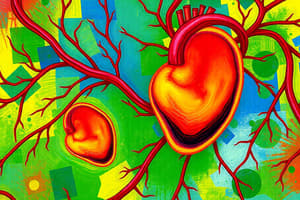Podcast
Questions and Answers
Relaciona las siguientes estructuras especializadas con su función durante la septación cardiaca:
Relaciona las siguientes estructuras especializadas con su función durante la septación cardiaca:
Válvulas tricúspide y mitral = Controlan el flujo sanguíneo entre las aurículas y ventrículos Canal aurículo-ventricular común = Se separa en las válvulas tricúspide y mitral Ridge ventricular superior e inferior = Se fusionan para formar el tabique ventricular Tabique ventricular = Evita la mezcla de sangre oxigenada y desoxigenada
Empareja los siguientes eventos morfogenéticos con su función en la separación de las cámaras cardiacas:
Empareja los siguientes eventos morfogenéticos con su función en la separación de las cámaras cardiacas:
Desarrollo de válvulas tricúspide y mitral = Previenen el reflujo sanguíneo entre las cámaras Migración de crestas ventriculares = Forman el tabique ventricular Separación del canal aurículo-ventricular = Da origen a las válvulas tricúspide y mitral Cierre de las válvulas aurículo-ventriculares = Evita el reflujo sanguíneo
Relaciona los siguientes conceptos clave con su importancia en la septación cardiaca:
Relaciona los siguientes conceptos clave con su importancia en la septación cardiaca:
Eficiente flujo sanguíneo unidireccional = Garantiza la circulación efectiva de sangre Desarrollo de estructuras especializadas = Configura la anatomía funcional del corazón Prevención de mezcla de sangre oxigenada y desoxigenada = Mantiene adecuado suministro de oxígeno a los tejidos Formación del tabique ventricular = Separa las cámaras cardiacas para funciones específicas
Empareja los siguientes elementos anatómicos con su papel en la septación cardiaca:
Empareja los siguientes elementos anatómicos con su papel en la septación cardiaca:
Relaciona las siguientes etapas del desarrollo del sistema cardiovascular con su descripción correspondiente:
Relaciona las siguientes etapas del desarrollo del sistema cardiovascular con su descripción correspondiente:
Empareja los siguientes conceptos relacionados con la septación cardíaca con su significado correspondiente:
Empareja los siguientes conceptos relacionados con la septación cardíaca con su significado correspondiente:
Relaciona las siguientes partes del corazón embrionario con sus funciones correspondientes:
Relaciona las siguientes partes del corazón embrionario con sus funciones correspondientes:
Flashcards
Cardiac Septation
Cardiac Septation
The process of dividing the heart into separate chambers during embryonic development.
Primordial Heart Tube
Primordial Heart Tube
The initial structure formed during heart development, made of endocardial and myocardium cells.
Atria
Atria
The upper chambers of the heart responsible for receiving blood.
Ventricles
Ventricles
Signup and view all the flashcards
Tricuspid Valve
Tricuspid Valve
Signup and view all the flashcards
Ventricular Septum
Ventricular Septum
Signup and view all the flashcards
Heart Valves
Heart Valves
Signup and view all the flashcards
Study Notes
Embryology Cardiovascular System: Cardiac Septation
The development of the heart involves a complex process called cardiac septation, which occurs during embryonic life. This process is essential for creating separate chambers within the developing heart, ensuring proper blood flow and circulation. Here, we will explore how this process unfolds, starting with the formation of the first heart tube and ending with the separation of the four chambers of the mature heart.
Formation of First Heart Tube
At around three weeks post conception, the paired heart fields begin to fold towards each other in the ventral body midline, forming a structure known as the primordial heart tube. This tube consists of endocardial cells lined with myocardium, which is made up of smooth muscle cells and connective tissue. The primitive heart begins to pump blood into the embryo's circulation network, supplying nutrients to different parts of the growing organism.
Subsequent Development
As the embryo develops further, the heart tube undergoes several transformations. Initially, it elongates and changes its shape from a simple tube to a more complex looped structure with bulging areas that will eventually become the atria. Next, the heart tube undergoes two major bends—the first one leading to the outflow tract, which becomes the future aorta, while the second bend forms the inlet portion, consisting of both atria and ventricles.
Separation of Atrium and Ventricle
During cardiac septation, the heart undergoes a series of morphogenetic events that lead to the formation of separate chambers within the heart. These events involve the development of specialized structures called valves that control blood flow between the chambers and prevent backflow of blood.
In the inlet portion of the heart, the most distinct change takes place where the right and left atria meet the right and left ventricles. The common atrio-ventricular canal separates into the tricuspid and mitral valves, also referred to as the right and left AV valves. These valves serve as flaps that open when their respective atria contract and close tightly when they relax, preventing blood from flowing back into the atria after entering the ventricles.
Furthermore, there is another significant event in cardiac septation: the development of ventricular septum. This septum separates the right ventricle from the left ventricle and prevents mixing of oxygenated and deoxygenated blood. It is formed by the fusion of the superior and inferior ventricular ridges, which migrate toward each other until they meet in the center of the ventricle. The resultant ventricular septum ensures efficient and unidirectional blood flow throughout the heart.
Completion of Cardiac Septation
By the end of cardiac septation, the mature heart has developed into a four-chambered organ with clearly defined atrial and ventricular compartments separated by specialized valves and septa. Each chamber performs specific functions within the circulatory system, allowing for efficient delivery of oxygen and nutrient-rich blood to various tissues and organs, and the return of oxygen-depleted blood to the lungs for reoxygenation.
Conclusion
Cardiac septation is a critical stage in embryological development that shapes the structure and function of the heart. This process involves the formation of specialized structures such as atria, ventricles, valves, and septum, all of which work together to ensure efficient blood circulation and maintain proper physiological functions throughout an individual's lifetime. Understanding the details of cardiac septation provides valuable insights into cardiovascular diseases, abnormalities, and potential therapeutic interventions.
Studying That Suits You
Use AI to generate personalized quizzes and flashcards to suit your learning preferences.





